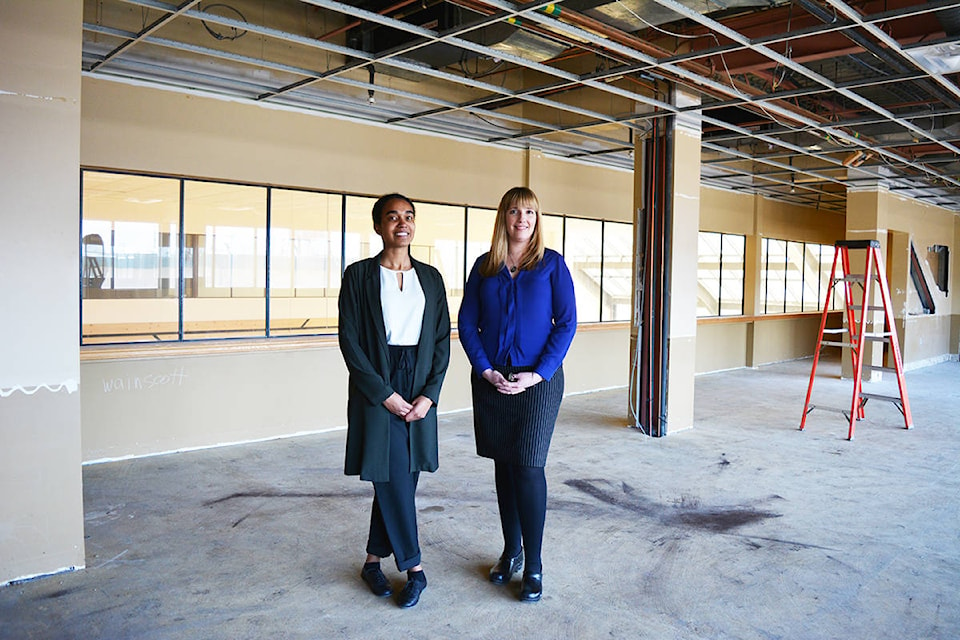Construction is underway on the City of Quesnel’s new Forestry Innovation Centre, and the City’s new Forestry Initiatives Program is up and running.
The City announced Wednesday (March 20) that the Forestry Initiatives Program (FIP), which began in January, is officially underway and moving forward.
The program, which is operated by Forestry Initiatives Manager Erin Robinson and Forestry Initiatives Co-ordinator Taddea Kunkel, was created to address the multiple challenges facing our community at this time — mainly protecting our communities from wildfire, rehabilitating the land after wildfire, and finding ways of innovating the forest products manufacturing sector, according to a press release from the City.
“Quesnel is one of the most forest-dependent communities in B.C., so it’s important that the City is taking an active role in advancing the Community Wildfire Protection Plan (CWPP), working with the provincial government on rehabilitating the landscape, and working with the forest industry to diversify the economy,” Robinson said in the news release. “This does not mean stepping back from forestry, but rather finding innovative ways to utilize the available wood-fibre and types of manufacturing potential already here in the area.”
The Forestry Initiatives Program emerged from the Future of Forestry Think Tank process, which brought together 65 technical experts in May of 2018 with a wide range of knowledge and expertise to discuss land management and innovation in the manufacturing of wood.
“This is very unique, and the City has great leadership and is being really proactive,” said Robinson.
READ MORE: Quesnel Think Tank calls for ‘forest resiliency’ to keep sector viable
Robinson says they are hoping to have the Forestry Innovation Centre, which is located in City Hall, completed by the middle of June.
“This is going to give us space for three permanent offices and also five visiting researcher spots; we’re going to have a big table that’s fully equipped for five visiting researchers,” she said, walking around the empty space. “This space is going to showcase all the different wood products we have in the local area; so everything we produce here, dimensional lumber, plywood, MDF, finishing products for walls that come from C&C Wood Products; so your barnboard, your wainscotting. We’re relying on some artisans for wood furniture and signage. That’s the one aspect of it, showcasing everything we offer here. And then showing what’s possible to make with wood into the future, so we’re going to have display areas and storyboards about different types of products that are available, or the research and development of what might be possible, and what we can do here in Quesnel.”
This centre will be the home of the Forestry Initiatives Program.
“City council created this program as a response to the change in the landscape and the changes we need to see happen in manufacturing,” said Robinson. “A nice way to sum it up is ‘how do we match our manufacturing to what’s coming off the landscape?’ We’re seeing a decrease in those big saw logs, so how do we re-tool what we already do well here in Quesnel?”
“It’s not stepping away [from forestry], but rather innovating it and seeing what is possible for the future,” added Kunkel.
That includes your wood composites, biofuels, bioplastics, bio-oils, nanocrystalline cellulose and lignin, explained Robinson.
Robinson explains the FIP has four pillars: implementing a Community Wildfire Protection Plan (CWPP); a landscape-level analysis and restoration project in partnership with the provincial government and First Nations governments, as well as industry and academic partners; diversifying manufacturing; and advocating for a community forest.
Since the program started in January, they have been working to advance the CWPP, focusing on some fuel treatment areas, according to Robinson. They are doing prescription development at the moment, and they hope to be treating some areas within the municipal boundary this spring.
Along with implementing the CWPP to protect homes, businesses and infrastructure, the FIP will also focus on encouraging homeowners and business owners to FireSmart their properties. The FIP also aims to work with the provincial government and academic partners to restore the land after insect outbreaks, fires and floods and figure out new ways to manage for ecosystem resilience.
As well, the City is currently working with community partners on a manufacturing analysis — looking at what is being produced around the world and by whom, what the market demands are right now, and what can be done here in Quesnel, explained Robinson, who describes it as a “high-level scan.”
Moving forward on the landscape-level analysis and restoration, the City will be holding a technical session on April 12.
As part of advocating for a community forest, the City of Quesnel has submitted a letter of intent to Doug Donaldson, the minister of Forests, Lands, Natural Resource Operations and Rural Development, requesting a letter of invitation for a community forest with the Lhtako Dene First Nation so it’s a joint partnership, explained Robinson.
The FIP is made possible through funding provided by the City of Quesnel, BC Rural Dividend, Community Resiliency Investment Program, Forestry Enhancement Society of British Columbia, and Cariboo Strong.
More information about the program, as well as updates, can be found on the City’s website under quesnel.ca/city-hall/major-initiatives.
Lindsay Chung
email
Like the Quesnel Cariboo Observer on Facebook
